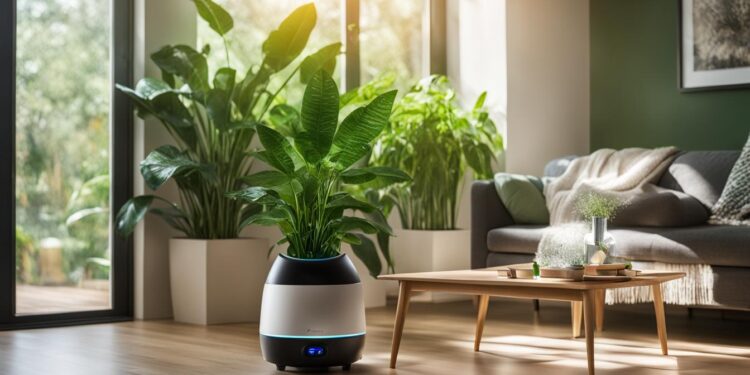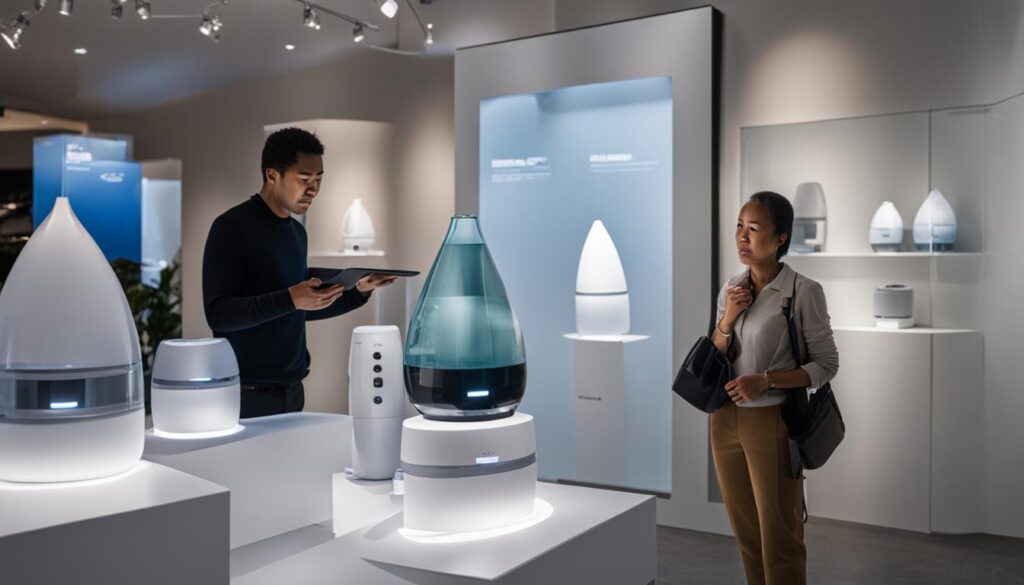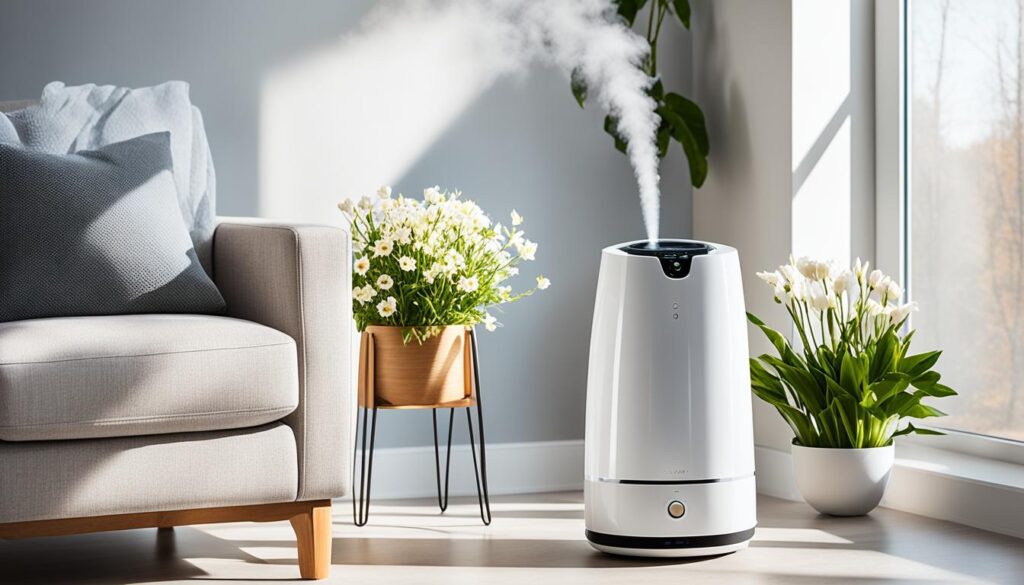How Humidifiers Can Alleviate Allergy Symptoms

Are you tired of struggling with allergy symptoms and looking for a natural solution to find relief? Look no further than humidifiers. These handy devices have been proven to alleviate allergies and improve indoor air quality, leading to better respiratory health.
A study conducted by the American Academy of Allergy, Asthma, and Immunology found that maintaining proper humidity levels between 40-60% can significantly reduce the presence of airborne allergens, such as dust mites and mold. By controlling the humidity in your home, you can create an environment that is less inviting to these common allergens, easing your allergy symptoms.
According to the Mayo Clinic, using a humidifier can also soothe dry nasal passages, ease congestion, and alleviate symptoms like coughing and sneezing. By adding moisture to the air, humidifiers provide relief and help you breathe more comfortably.
So, whether you suffer from seasonal allergies or indoor allergens, humidifiers can be an effective tool in your allergy management plan. Let’s explore the benefits of using humidifiers for allergy relief, and how they can make a difference in your respiratory health.
Key Takeaways:
- Humidifiers can alleviate allergy symptoms and improve indoor air quality.
- Maintaining proper humidity levels between 40-60% reduces the presence of allergens.
- Humidifiers soothe dry nasal passages and ease congestion.
- Humidifiers can be a natural and effective solution for allergy relief.
- Consult with a healthcare professional to determine the best humidifier for your specific allergy needs.
Understanding Allergies and Their Impact on Health
Allergies can significantly impact a person’s health, causing a range of bothersome symptoms and discomfort. Understanding the nature of allergies, including their triggers and effects on indoor air quality, is essential for effective management and relief.
Allergy symptoms can manifest in various ways, such as sneezing, itching, and congestion. These symptoms are a result of the immune system overreacting to allergens, substances that the body considers harmful. Common allergens include pollen, dust mites, pet dander, and mold.
Allergens can be found both outdoors and indoors, with indoor allergens posing a particular challenge for individuals with indoor allergies. Poor indoor air quality, often caused by factors like humidity and inadequate ventilation, can exacerbate allergy symptoms and contribute to respiratory issues.
To gain a better understanding of the impact of allergies on health, it is crucial to recognize the interplay between allergens and indoor air quality. By addressing indoor air quality and minimizing exposure to allergens, individuals can effectively manage their allergies and improve their overall well-being.
Allergy Symptoms
Allergy symptoms can vary depending on the individual and the specific allergens involved. Common allergy symptoms include:
- Sneezing
- Itching
- Congestion
- Runny or stuffy nose
- Watery or itchy eyes
- Coughing
- Skin rash or hives
Allergy Triggers
Understanding the common allergy triggers can help individuals identify and manage their allergies more effectively. Some common allergy triggers include:
- Pollen
- Dust mites
- Pet dander
- Mold spores
- Certain foods
- Insect stings
Indoor Air Quality
Indoor air quality refers to the quality of the air within buildings, including homes, offices, and other indoor spaces. Poor indoor air quality can result from various factors, such as:
- High humidity
- Poor ventilation
- Chemical pollutants
- Tobacco smoke
- Dust and allergens
“Addressing indoor air quality is crucial for managing allergies. By reducing allergen exposure and maintaining proper ventilation, individuals can create a healthier indoor environment.”
| Allergens | Common Sources | Actions to Minimize Exposure |
|---|---|---|
| Pollen | Outdoor air, plants | Keep windows closed during high pollen days, regularly clean indoor surfaces |
| Dust mites | Bedding, upholstered furniture, carpets | Use allergen-proof covers on bedding, wash bedding regularly in hot water, and vacuum frequently |
| Pet dander | Animal fur, saliva, urine | Limit exposure to pets, designate pet-free areas in the home, regularly groom and clean pets |
| Mold spores | Damp areas, bathrooms, basements | Control humidity levels, fix leaks and water damage promptly, use exhaust fans in moist areas |
| Chemical pollutants | Cleaning products, paints, solvents | Choose low-chemical or natural alternatives, ventilate the area while using chemicals |
The Role of Humidity in Allergy Relief
Maintaining optimal humidity levels is crucial for alleviating allergy symptoms and promoting respiratory health. The right humidity level can make a significant difference in reducing allergy-triggering factors and creating a more comfortable indoor environment. Let’s explore how humidity affects allergy symptoms and why it plays a vital role in respiratory health.
The Impact of Humidity on Allergy Symptoms
Humidity levels directly affect individuals with allergies as they can influence the severity and frequency of symptoms. Here’s a breakdown of how different humidity levels can impact allergy sufferers:
| Humidity Level | Allergy Symptoms |
|---|---|
| Low Humidity (Below 40%) |
|
| High Humidity (Above 60%) |
|
| Ideal Humidity (40-60%) |
|
As the table demonstrates, maintaining humidity levels within the ideal range of 40-60% is crucial for managing allergy symptoms effectively and improving respiratory health. This range provides a balanced environment that deters the growth of allergens while ensuring optimal comfort for individuals with allergies.
Humidifiers: Regulating Humidity for Allergy Relief
Humidifiers are valuable tools in achieving and maintaining the ideal humidity range. These devices emit moisture into the air, helping to regulate humidity levels and alleviate allergy symptoms. By adding moisture, humidifiers can:
- Soothe dry nasal passages
- Reduce congestion and improve breathing
- Mitigate respiratory irritation
- Minimize the presence of airborne allergens
How Humidifiers Alleviate Allergy Symptoms
Humidifiers provide relief from allergy symptoms in several ways. By releasing moisture into the air, they help soothe dry nasal passages, reducing congestion and making it easier to breathe. Adequate humidity levels also minimize irritation in the respiratory system, alleviating symptoms like coughing and throat discomfort. Additionally, by reducing the presence of airborne allergens, such as dust mites and mold spores, humidifiers create a healthier indoor environment and lessen the burden on allergy sufferers.
| Benefits of Humidifiers for Allergy Relief | How Humidifiers Work |
|---|---|
|
|

“Using a humidifier can provide immediate relief for allergy sufferers by creating a more comfortable and allergen-free indoor environment.” – Dr. Anna Thompson, Allergist
Humidifiers offer an effective solution for allergy relief, as they address multiple aspects of allergy symptoms. The soothing moisture produced by humidifiers helps alleviate congestion, making it easier to breathe and relieving discomfort caused by dry nasal passages. This provides much-needed relief for individuals experiencing allergy-related congestion and sinus pressure.
Moreover, humidifiers aid in allergen reduction by creating an environment that is less favorable for the growth of dust mites and mold spores. These common allergens thrive in dry environments, and by maintaining optimal humidity levels, humidifiers limit their presence. This reduction in allergen exposure can significantly alleviate allergy symptoms and improve overall respiratory health.
Additionally, humidifiers can help prevent dryness in the respiratory system, which can further aggravate allergy symptoms such as coughing and throat discomfort. By introducing moisture into the air, humidifiers minimize irritation and provide relief from these bothersome symptoms.
Overall, humidifiers play a vital role in alleviating allergy symptoms by providing congestion relief, soothing dry nasal passages, and reducing allergens in the air. Incorporating a humidifier into your allergy management routine can contribute to a healthier indoor environment and improved quality of life for allergy sufferers.
Choosing the Right Humidifier for Allergy Relief
When it comes to selecting a humidifier for allergy relief, it’s important to consider various factors to ensure optimal performance and effectiveness. Different types of humidifiers are available in the market, each offering its own unique benefits and features. By understanding the options and considering your specific allergy needs, you can choose the right humidifier that will provide the relief you seek.
Types of Humidifiers:
There are three main types of humidifiers commonly used for allergy relief:
- Evaporative Humidifiers: This type of humidifier uses a fan to blow air through a moistened wick or filter, causing the water to evaporate and increase humidity in the room.
- Ultrasonic Humidifiers: Utilizing ultrasonic vibrations, these humidifiers produce a cool mist by breaking water into fine droplets. They are often quiet and energy-efficient.
- Steam Humidifiers: Also known as vaporizers, steam humidifiers heat water to produce steam, which is released into the room to increase humidity levels.
Each type has its own advantages, so consider your preferences and needs when deciding which one to choose.
Allergy-Friendly Features:
When selecting a humidifier, look for features that are specifically designed to provide allergy relief and promote a healthier indoor environment. Some key considerations include:
- Built-in Filters: Humidifiers with built-in filters can help eliminate allergens, such as dust mites and mold spores, from the water before releasing moisture into the air.
- Adjustable Humidity Settings: Opt for a humidifier that allows you to adjust and control the humidity levels. This feature helps you maintain the ideal humidity range of 40-60% for allergy relief.
Maintenance:
Maintaining your humidifier is essential to ensure its optimal performance and prevent the growth of mold and bacteria. Regular cleaning and proper maintenance are critical for allergy sufferers as unclean humidifiers can worsen symptoms. Follow the manufacturer’s instructions for cleaning and disinfecting your humidifier regularly. Consult with a healthcare professional or allergist for specific maintenance recommendations based on your allergy needs.

Consult with a healthcare professional to determine the most suitable type of humidifier for your specific allergy needs. They can provide valuable guidance and recommendations based on your individual circumstances.
Additional Measures for Allergy Relief
While humidifiers can provide significant allergy relief, they work best in conjunction with other measures. Allergy-proofing your home by keeping it clean, minimizing dust buildup, and using hypoallergenic bedding can further reduce allergen exposure.
Air purifiers can help remove allergens from the air, complementing the work of a humidifier. These devices are designed to capture and trap particles like pollen, pet dander, and dust mites, ensuring cleaner and fresher indoor air. By improving indoor air quality, air purifiers can significantly reduce allergy symptoms.
Additionally, maintaining a regular cleaning routine, especially in areas prone to moisture and allergen accumulation, is essential for optimal allergy management. Dusting, vacuuming, and mopping on a regular basis helps eliminate allergens from surfaces and prevents them from entering the air.
“Allergy-proofing your home is crucial in creating an environment that promotes allergy relief and better respiratory health. By combining the use of a humidifier, air purifier, and regular cleaning routines, individuals can effectively minimize allergen exposure and experience relief from allergy symptoms.”
Allergy Relief Measures Comparison
| Allergy Relief Measures | Benefits |
|---|---|
| Allergy-proofing your home | – Reduces allergen exposure – Promotes better respiratory health |
| Air purifiers | – Removes airborne allergens – Improves indoor air quality |
| Regular cleaning routines | – Eliminates allergens from surfaces – Prevents allergen build-up |
Implementing additional measures alongside the use of a humidifier creates a comprehensive approach to allergy relief. By adopting these practices, individuals can create a clean and allergen-free environment, improving their overall well-being and respiratory health.

Potential Drawbacks and Precautions
When using humidifiers for allergy relief, it is essential to be aware of potential drawbacks and take necessary precautions to ensure safe and effective usage.
Over-humidification
One common concern with humidifiers is over-humidification, where humidity levels exceed the recommended range of 40-60%. This can lead to issues such as mold and mildew growth, which can worsen allergies and respiratory conditions. It’s important to monitor humidity levels regularly and adjust the humidifier settings accordingly to maintain optimal moisture levels.
Mold Growth
Mold can thrive in high humidity environments, posing a risk to allergy sufferers. Regular cleaning and maintenance of the humidifier are crucial to prevent mold growth. Emptying and refilling the water tank with fresh water daily helps minimize the accumulation of stagnant water and mold formation. Additionally, using distilled or demineralized water can reduce the release of minerals into the air, further mitigating the risk of respiratory irritation.
Regular Cleaning
Regular cleaning of the humidifier is essential to maintain its efficacy and prevent the buildup of bacteria and allergens. Follow the manufacturer’s instructions for cleaning and disinfection, which typically involve using mild detergent or vinegar to clean the water tank and other removable parts. Wiping down the exterior surfaces regularly can also help keep the humidifier free from dust and other particles that can worsen allergies.
To ensure the safe and effective use of a humidifier for allergy relief, it’s advisable to consult with a healthcare professional or allergist. They can provide personalized guidance and recommendations based on individual allergy triggers and specific health conditions.
Monitoring and Maintaining Humidity Levels
Properly monitoring and maintaining humidity levels is crucial for optimizing allergy relief and ensuring a healthy indoor environment. Hygrometers, devices that measure humidity levels, play a vital role in this process. By accurately assessing the humidity in your space, you can take appropriate measures to adjust it as needed.
“A hygrometer is an indispensable tool for maintaining an ideal humidity range.”
– Dr. Sarah Adams, Allergist
The ideal humidity range for allergy relief is typically recommended to be between 40-60%. This range helps inhibit the growth of allergens like mold and dust mites, creating an environment that is less conducive to respiratory triggers. Regularly monitoring your humidity levels ensures that you stay within this optimal range.
To adjust humidity levels effectively, you can utilize either a humidifier or a dehumidifier based on the reading provided by the hygrometer.
“In cases of low humidity, a humidifier can help add moisture to the air, while a dehumidifier can reduce excess moisture in cases of high humidity.”
– Dr. Mark Carter, Pulmonologist
It is essential to note that excessively high or low humidity levels can have adverse effects on health. High humidity can promote the growth of mold, exacerbating allergy symptoms, while low humidity can lead to dry nasal passages, making individuals more susceptible to allergens. Regular monitoring and adjustments are necessary to maintain a healthy and balanced indoor environment.
Benefits of Monitoring Humidity with Hygrometers:
- Accurate assessment and monitoring of humidity levels
- Prevention of mold and dust mite growth
- Optimization of allergy relief and respiratory health
- Creation of a comfortable and healthy indoor environment
By incorporating hygrometers into your allergy management routine, you can effectively maintain an ideal humidity range and ensure a space that promotes well-being.
Expert Recommendations on Humidifiers for Allergy Relief
Allergists and healthcare professionals commonly recommend the use of humidifiers as part of allergy management.
Well-maintained humidifiers with appropriate humidity levels can significantly alleviate allergy symptoms, improve respiratory health, and enhance overall indoor air quality.
However, it is essential to consult with a healthcare professional or allergist to determine the suitability of a humidifier and ensure proper usage based on individual allergy triggers and specific health conditions.
Conclusion
Using a humidifier is a valuable solution for allergy relief, promoting improved respiratory health and maintaining optimal indoor air quality. By regulating humidity levels and reducing airborne allergens, humidifiers effectively alleviate allergy symptoms and provide much-needed comfort. However, it is essential to consult with a healthcare professional to determine the best approach for your specific allergy needs.
Regular usage of a humidifier, combined with other allergy management measures, can have a profound impact on respiratory health. By maintaining proper humidity levels and soothing dry nasal passages, individuals can experience significant relief from symptoms such as congestion, coughing, and sneezing. Additionally, reducing the presence of allergens like dust mites and mold spores creates a healthier indoor environment, fostering improved overall well-being.
To create an optimal indoor environment for allergy relief, it is crucial to consult with a healthcare professional or allergist. They can offer expert guidance and recommendations based on individual allergy triggers and health conditions. By leveraging the benefits of a humidifier and implementing other allergy management strategies, individuals can enjoy a better quality of life with reduced allergy symptoms and improved respiratory health.
FAQ
How do humidifiers alleviate allergy symptoms?
Humidifiers alleviate allergy symptoms by releasing moisture into the air, soothing dry nasal passages, reducing congestion, and minimizing irritation in the respiratory system. They also help reduce the presence of airborne allergens, such as dust mites and mold spores, creating a healthier indoor environment.
What are common allergens that can cause allergies?
Common allergens that can cause allergies include pollen, dust mites, pet dander, and mold. These allergens can be found both outdoors and indoors, with indoor allergies being especially problematic for some people.
How does humidity impact allergy relief?
Proper humidity levels are essential for allergy relief. Low humidity can lead to dry nasal passages, making individuals more susceptible to allergens. High humidity promotes the growth of mold and dust mites, increasing exposure to allergens. Maintaining humidity levels between 40-60% helps keep allergen levels in check and ensures optimal respiratory health.
What types of humidifiers are available for allergy relief?
There are different types of humidifiers available, including evaporative, ultrasonic, and steam humidifiers. It is important to select a humidifier with features such as built-in filters to remove allergens from the water and adjustable humidity settings.
How can I allergy-proof my home in addition to using a humidifier?
To allergy-proof your home, keep it clean, minimize dust buildup, and use hypoallergenic bedding. Air purifiers can help remove allergens from the air. Regular cleaning routines, especially in areas prone to moisture and allergen accumulation, are also crucial.
What are the potential drawbacks and precautions of using a humidifier?
Over-humidification can lead to mold and mildew growth. Regular cleaning and maintenance of the humidifier, as well as using distilled or demineralized water, are important to prevent these issues. Consult with a healthcare professional or allergist for safe and effective use of a humidifier.
How can I monitor and maintain humidity levels in my home?
Hygrometers can be used to monitor indoor humidity levels. The ideal humidity range of 40-60% should be maintained for optimal allergy relief. Adjusting humidity levels can be done by using a humidifier or dehumidifier based on the current reading.
What do experts recommend regarding the use of humidifiers for allergy relief?
Allergists and healthcare professionals commonly recommend the use of humidifiers as part of allergy management. Well-maintained humidifiers with appropriate humidity levels can significantly alleviate allergy symptoms, improve respiratory health, and enhance overall indoor air quality.
Can humidifiers alone provide complete allergy relief?
While humidifiers can provide significant allergy relief, they work best in conjunction with other measures. Allergy-proofing your home, using air purifiers, and maintaining a regular cleaning routine are important for optimal allergy management.
How can using a humidifier improve respiratory health and indoor air quality?
Using a humidifier can improve respiratory health and indoor air quality by alleviating allergy symptoms, maintaining proper humidity levels, reducing airborne allergens, and soothing dry nasal passages. This leads to a healthier environment and improved well-being.






